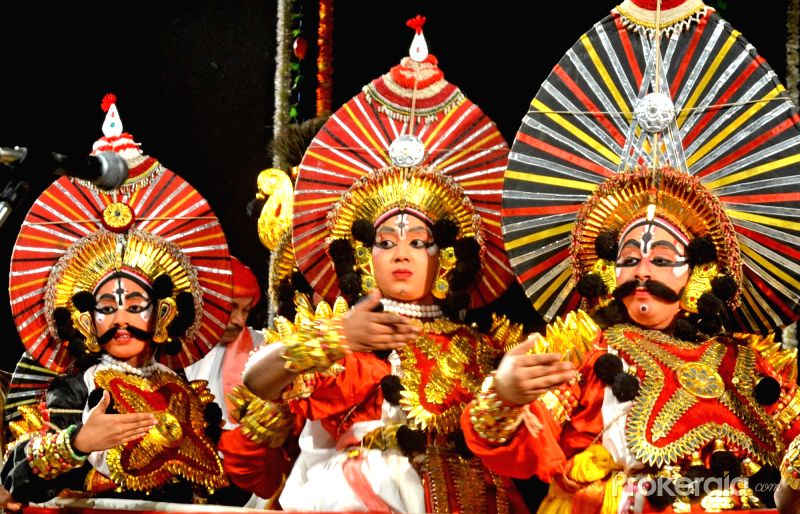Yaksha Gana | Yakshagana

Yakshagana is the name for a group of musical dramas popular in southern India. It is a traditional theatre form that combines dance, music, dialogue, costume, make-up, and stage techniques with a unique style and form. It is developed in Paduvalapaya (the western basis) Yakshagana practiced in the western Karnataka state. Yakshagana is traditionally presented from dusk to dawn.
Origin
Yakshagana is believed to have evolved from pre-classical folk music forms and theatrical arts prevalent in what is now the states of Maharashtra, Karnataka, Andhra Pradesh, Tamil Nadu, and Kerala. The origin of Yakshagana is somewhere in the period of the 11th to 16th centuries CE but has a great similarity to the traditional theatrical regional forms such as the Kathakali of Kerala, the Bhagavata Mela of Tamilnadu, and the Veedhinatakam of Andhra Pradesh.
The Yakshagana is an Operatic form of traditional theatre with a hoary tradition of at least a thousand years. It flourished chiefly in the coastal regions of Karnataka and is seen to have a great influence on the rites and rituals of many ancient temples of this region besides being a part of the choral hymns of many old-fashioned weddings.
Yakshagana in its present form is believed to have been strongly influenced by the Vaishnava Bhakti movement. The Yakshagana form of today is the result of slow evolution, drawing its elements from the ritual theater, temple arts, secular arts, royal courts of the past, and the artists’ imaginations—all interwoven over a period of several hundred years.
The other forms of Yakshagana are Moodalapaya (the eastern basis) or Doddaata and Sannaata in Karnataka, Chindu Yakshagana, Bhagavatha Mela and Kuchupudi Bhagavatamelam in Andhra and Melattur Bhagavatamelam (migrated to) in Tamil Nadu.
Dance Form
The art form draws all its inspiration entirely from the movements of the ritualistic dances offered in the worship of the Snake- God, Naga, propitiated from, perhaps, the prehistoric times, by the earliest cultures that inhabited the area known as the Nagamandala.
The art form is an admixture of dance and music, with a theme incorporated in it. The theme invariably eulogizes the triumph of the good over evil and is generally chosen from the episodes of either the Mahabharata or the Ramayana or the Puranas. The dancer dances to the lines sung by the Bhagavatha. The Bhagavatha pauses and the actor-dancer indulges himself in impromptu dialogues and converses about everything relating to the episode that is in progress, to the situations faced in contemporary everyday life.
A striking feature of the Yakshagana is the observation of the poorvarangavidhi or the preliminary offerings on stage before the actual play is staged as described in Bharata’s Natya Shastra. The ritual is followed even to this day after which the presentation begins. Here it is identified by the term Sabhalakshana.
The very first dance is of the Kodangis or the dance of the under trainees, just as the sunsets, which is followed by obeisance to Lord Ganesha. The Vidushaka then carries the
deity to the area of performance accompanied by the musical ensemble where an arati is conducted ceremoniously.
The play begins with an introductory dialogue giving the audience an idea of the prasanga to be enacted for the evening. It is also to be noticed that some of these troupes are maintained or patronized by the temples in South Kanara districts of Karnataka which emphasizes the fact that ritual and the traditional theatre of Yakshagana are very closely related. Devotees offer to organize a drama by the troupe of a particular temple to initiate the deity and to appease her in their times of stress and trial or to beget a child and the like.

Costumes
The costumes (or vesha) in Kannada depend on the characters depicted in the play (prasanga). It also depends on the Yakshagana style (tittu). Yakshagana costumes consist of headgear (Kirita or Pagade), Kavacha that decorates the chest, Buja Keerthi (armlets) that decorate the shoulders, and belts (Dabu)—all made up of light wood and covered with gold foil.
The basic male costume consists of black loose-fitting pajama bottoms, strings of tiny bells wrapped securely around their ankles and a ten-yard red and golden yellow checked cloth. The cloth is wrapped and tied in a distinctive manner so that the performer may dance and perform according to the strenuous physical demands of his role. He also wears a short or long sleeve jacket of red, green, or dark blue according to his character type. His waist, chest, arm, and shoulder ornaments further serve to define him and the genre in which he performs. Elaborate and distinctive lotus-shaped headdresses wrapped and tied entirely by the actor signify exactly what character he is playing. Makeup is yet another way for spectators to identify one character from another.






